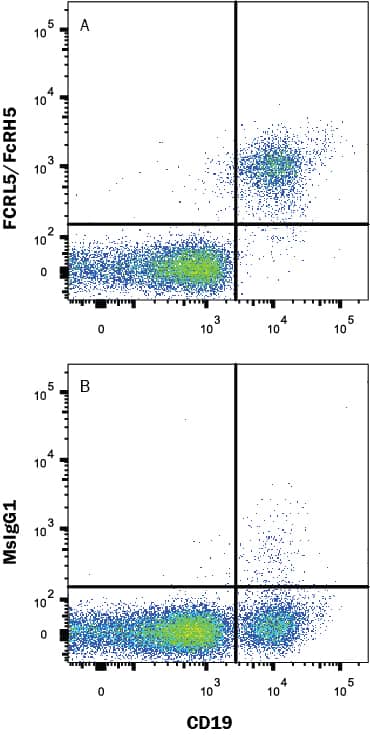Human FCRL5 Antibody
R&D Systems, part of Bio-Techne | Catalog # MAB20872


Key Product Details
Species Reactivity
Applications
Label
Antibody Source
Product Specifications
Immunogen
Gln16-Arg844
Accession # Q96RD9
Specificity
Clonality
Host
Isotype
Scientific Data Images for Human FCRL5 Antibody
Detection of FCRL5 in Human Lymphocytes by Flow Cytometry.
Human blood-derived lymphocytes were stained with (A) Mouse Anti-Human FCRL5 Monoclonal Antibody (Catalog # MAB20872) or (B) Mouse IgG1 isotype control antibody (MAB002), followed by Allophycocyanin-conjugated Anti-Mouse IgG F(ab')2 Secondary Antibody (F0101B) and PE-conjugated Mouse Anti-Human CD19 Monoclonal Antibody (FAB4867P).Applications for Human FCRL5 Antibody
CyTOF-ready
Flow Cytometry
Sample: Human Peripheral Blood Lymphocytes
Formulation, Preparation, and Storage
Purification
Reconstitution
Formulation
Shipping
Stability & Storage
- 12 months from date of receipt, -20 to -70 °C as supplied.
- 1 month, 2 to 8 °C under sterile conditions after reconstitution.
- 6 months, -20 to -70 °C under sterile conditions after reconstitution.
Background: FCRL5
Fc Receptor-Like 5 (FCRL5), also known as FcRH5, IRTA2, and CD307, is a 120 kDa protein with sequence homology to classical Fc receptors. The type 1 transmembrane FCRL proteins contain from three to nine immunoglobulin-like domains. They are differentially expressed within the B cell lineage and can either promote or inhibit B cell proliferation and activation (1, 2). According to R&D Systems testing, FCRL5 binds to purified human IgG with high affinity. Mature human FCRL5 consists of a 836 amino acid (aa) extracellular domain (ECD) with nine Ig-like domains, a 21 aa transmembrane segment, and a 105 aa cytoplasmic domain with one immunotyrosine activation motif (ITAM) and two immunotyrosine inhibitory motifs (ITIMs) (1, 3). Mouse FCRL5 contains only five Ig-like domains in its ECD. It shares 49% aa sequence identity with human FCRL5 within common regions. Alternate splicing of human FCRL5 generates isoforms that consist of approximately the first one, six, or eight Ig-like domains (3, 4). FCRL5 expression is restricted to mature B lineage cells in lymphoid tissues and blood (3, 5‑7). Its ligation inhibits signaling through the B cell antigen receptor (8). Epstein-Barr virus transformation of B cells induces the up‑regulation of surface FCRL5 by a direct effect of its EBNA2 protein on FCRL5 gene transcription (9). The FCRL5 gene maps to the 1q21 chromosomal locus, a common site of rearrangements in B cell malignancies, and the FCRL5 protein is preferentially expressed in cell lines with 1q21 abnormalities (3). FCRL5 is up‑regulated on tumor cells in some types of B cell malignancies (6, 10‑12). In addition, soluble FCRL5 is elevated in the serum of many B cell leukemia patients (11, 13).
References
- Davis, R.S. (2007) Annu. Rev. Immunol. 25:525.
- Maltais, L.J. et al. (2006) Nat. Immunol. 7:431.
- Hatzivassiliou, G. et al. (2001) Immunity 14:277.
- SwissProt # Q96RD9.
- Miller, I. et al. (2002) Blood 99:2662.
- Polson, A.G. et al. (2006) Int. Immunol. 18:1363.
- Vidal-Laliena, M. et al. (2005) Cell. Immunol. 236:6.
- Haga, C.L. et al. (2007) Proc. Natl. Acad. Sci. 104:9770.
- Mohan, J. et al. (2006) Blood 107:4433.
- Ise, T. et al. (2005) Clin. Cancer Res. 11:87.
- Ise, T. et al. (2007) Leukemia 21:169.
- Kazemi, T. et al. (2009) Cancer Immunol. Immunother. 58:989.
- Ise, T. et al. (2006) Clin. Chem. Lab. Med. 44:594.
Long Name
Alternate Names
Gene Symbol
UniProt
Additional FCRL5 Products
Product Documents for Human FCRL5 Antibody
Product Specific Notices for Human FCRL5 Antibody
For research use only